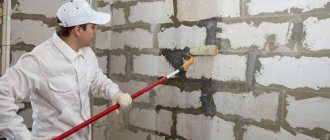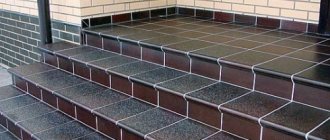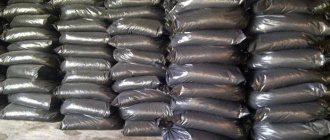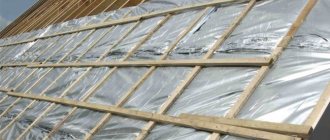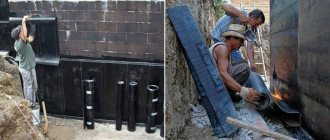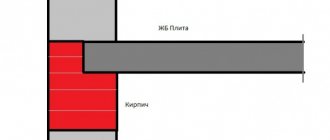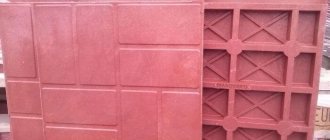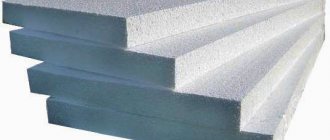Question from Valeria, Orenburg:
Hello, experts of the site “All about tiles”. I’m very interested in the question: is it possible to use foam blocks on a wall without plastering the surface first? I searched on the Internet, however, the answers were very varied. I'd like to hear your opinion. Thank you in advance.
Balin Alexander Vladimirovich answers:
Nowadays this material is actually quite common, which has very good thermal insulation properties, however, their strength, as a rule, is far from the same as that of concrete and the question of whether it is possible to lay tiles on foam concrete is very relevant.
The most important thing is to evaluate how well the installation work on laying foam concrete blocks was completed. Are there any unevenness on the walls or large differences?
In this case, painting the wall will not be any different from the usual process, so you can use the link to find out all the features of this work.
I also highly recommend priming the surface first. In each article on installation, we draw attention to the fact that you must follow all the rules to achieve the best result, and in your case, namely if the walls are made of foam concrete, you should use a deep penetration primer.
If the surface is not very smooth, then it is still better to pre-plaster the surface and then begin cladding.
Foam concrete is an excellent heat and sound insulating material; blocks made from it are light, pliable in processing, and easy to lay. Internal partitions in the house can be erected from blocks with your own hands without much effort and financial costs.
A bathroom and toilet made of foam blocks will be no worse than a cast sanitary cabin made of asbestos cement, partitions made of brick or plasterboard, but the performance qualities of the premises in terms of noise insulation will far exceed those of other materials.
In the article we will talk about brands of foam blocks for interior work, the technology for constructing partitions and methods of protecting bathroom walls from moisture.
Advantages of foam concrete blocks
You can build partitions in the house (see), separate the bathroom from the living area, and properly organize the space in the apartment using various materials. But foam blocks are in particular demand due to their unique technical and operational properties (see).
What attracts builders so much in this material:
- Light weight
compared to other materials does not put much pressure on the ceiling. - The dimensions of the blocks can significantly reduce the construction process time.
- Due to the ease of processing foam concrete
, it becomes possible to create architectural forms of various configurations (niches, arches, etc.). - Partitions made of foam concrete are easy to redevelop.
- High soundproofing qualities.
- Complete fire safety.
- Affordable price.
The disadvantages include:
- The material has high moisture absorption; therefore, a number of measures will have to be taken in the bathroom to protect the walls from moisture.
- Due to their porosity and softness, foam blocks have some restrictions on load, that is, hanging heavy cabinets on the walls is quite problematic. But this issue is easily resolved using a special one.
How to choose the right material
In order for the laying of foam blocks in an apartment to be of high quality, even and reliable, you need to choose the appropriate material.
For partitions, blocks of the following sizes are used (length x height x width):
- 600 x 300 x 150 mm.
- 600 x 300 x 100 mm.
- 600 x 200 x 75 mm.
- 600 x 200 x 50 mm.
Since the partition for the bathroom is self-supporting, that is, it is not subjected to any loads from above (ceiling, roof, etc.) and only holds its own pressure, foam concrete grade D400–D500 with strength class B2.5 is usually used for such structures.
Important! The thickness of the blocks is taken equal to or greater than the width of the door frame; later it will be easier to build a door slope than to think about how to improve the jamb protruding from the wall.
It is believed that for internal partitions the most optimal price-quality ratio is a block with a thickness of 100 mm; this will be quite enough to prevent the noise of a washing machine in the bathroom or the sound of pouring water from coming from the room. Between the bathroom and the toilet you can lay a partition 75 mm thick.
The foam block must meet the following characteristics:
- Accurate geometric and linear dimensions.
- A homogeneous surface without dark spots, various inclusions, etc.
- No cracks, chips, dents or bulges.
- Light gray color, partial or complete change of which indicates violations in the technological process.
We must remember that the smoother the surface and more precise the dimensions, the easier it will be to finish the walls (see), so you should select high-quality blocks.
Vinyl siding trim
Finishing the outside of aerated concrete walls with sheet materials is a reliable way to protect the structure. The house can be sheathed with vinyl siding, clapboard or ceramic, metal sheets, vertical or horizontal installation method.
- I recommend attaching the sheathing sheets to the sheathing.
- Install the sheathing on nails or expansion anchors. The lathing creates a ventilated space of 2...4 cm, which is extremely useful for removing condensation and additional insulation.
- Vinyl siding is often the best way to protect aerated concrete. Available in sizes 385x25.5 cm, thickness 1 mm.
Calculation of quantity of material
Divide the total surface area by the area of one panel to get the number of required panels. Don’t forget to add 7% to the resulting number, which will be spent on processing corners and difficult places.
Also see:
Comparison of types of siding for cladding a house
Choosing siding for logs. Main advantages
Adhesive for foam blocks
Since the amount of work is not large, it will be better if the laying of foam blocks in the apartment is carried out not with cement-sand mortar, but with special adhesive mixtures (see), which include:
- Cement.
- Fine sand.
- A modifier that keeps the mixture from premature cracking.
- A plasticizer that penetrates deep into the pores of foam concrete and ensures reliable adhesion of the blocks to each other.
The composition of the mixtures is similar to the structure of foam concrete, and after the glue has completely set, the wall acquires strength and solidity.
The seam between the blocks is made up to 3 mm thick, no more, so for 1 m2 of masonry, depending on the brand of the mixture used, the glue consumption will be approximately 2 to 6 kg, which is 4–6 times less than when using cement-sand mortar.
Important! When mixing the glue, the preparation instructions must be strictly followed, otherwise the adhesive properties of the solution will be impaired, which can lead to a weakening of the strength of the partition.
Key points of partition masonry technology
Before starting work, it is necessary to mark the location of the partition on the floor and wall, then, to lay the first row, install beacons along the marking to prevent the blocks from shifting during work.
You can use a metal profile for drywall as guides:
- First row of blocks.
If the wall is placed on a cement base, then it is enough to cover it with a primer and lay a layer of mortar under the blocks; when the floor is wooden, then to firmly fix the first row, it is recommended to screw in anchors or pins. We must remember that how accurately the first row lies, the partition will look even and aesthetically pleasing.
- Subsequent rows.
Since the thickness of the partition is relatively small, the foam block masonry in the bathroom should be reinforced with masonry mesh or individual rods every 2-3 rows (see), the ends of which should be drilled into the load-bearing wall at least 100 mm. In addition, securing the reinforcement will connect the existing wall and the new partition into a single structure and eliminate the risk of swaying, shifting or, in the worst case, collapse of the partition due to possible mechanical stress.
The doorway is also covered with two reinforcement rods or a corner, on which the blocks are then laid. If possible, you can use a standard jumper.
- The last row.
If, when bringing the masonry to the ceiling, a small gap remains, then it is sealed with polyurethane foam.
- The junction of two partitions.
If a separate bathroom is planned, then the partition separating the bathroom and toilet is also reinforced and the ends of the rods are laid between the blocks of the first partition and drilled into the load-bearing wall, thus creating a reliable connection.
This is all that concerns the technological process of laying partitions. But there are a few subtleties that you need to know when working with foam concrete:
- The laying of foam blocks in the bathroom must be carried out with mandatory bandaging of the seams, that is, the seams of each subsequent row should not coincide with the underlying ones, the shift is made by approximately half a block.
- Foam concrete absorbs moisture well, so in order to avoid moisture absorption and premature drying of the adhesive mixture, the blocks must be moistened with water before laying it.
- Due to the thinness of the partition, when laying several rows in a row, the wall may shift in plane, so it is recommended to let the glue set after each row.
- After completing the work, you need to putty the seams, various defects that arose during the masonry process, clean the surfaces from excess glue and allow the partition to dry thoroughly. After this, cover the wall with two layers of waterproof deep penetration primer, wait until it dries completely and begin further finishing work.
- All electrical and plumbing work is carried out after the glue has completely set; curing times should be looked at on the packaging with the mixture. Since foam concrete lends itself well to drilling, it will not be difficult to install pipes or install wiring.
Protection of foam concrete from moisture
The bathroom is considered the dampest room in the house, so the foam block masonry must be reliably protected from moisture penetration into the concrete body.
This is done in several ways:
- Plastering walls followed by coating with waterproof compounds (paint, varnish, etc.).
Since foam concrete is a rather soft material, it is recommended to attach a fiberglass reinforcing mesh to the walls before applying the plaster mortar. This is necessary for better adhesion of the solution to the surface of the foam blocks and obtain a better coating.
- Covering with moisture-resistant decorative panels or slabs (siding, PVC panels, etc.).
It is produced using a frame or frameless method. In the first case, a frame is mounted under the panels, on which the panels are hung; in the second version, the slabs are glued directly to the wall.
With this finishing, the masonry of foam blocks in the bathroom will be especially susceptible to dampness, so it is necessary to attach a vapor barrier membrane to the walls under the frame or facing material, which will not allow moisture to penetrate inside the masonry, but will lead it out.
In a separate toilet, it is not necessary to take such measures, but experts still recommend laying a vapor barrier at least spot-on, in problem areas - around pipes, ventilation holes, doorways, where condensation is possible.
- Cladding with decorative ceramic tiles.
In this case, the tiles will perfectly protect the foam concrete from dampness; only it is advisable to make the seams between the tiles as thin as possible and caulk them with a special grout containing moisture-resistant components. When using a simple mixture, mold or mildew may develop. But for ideal installation of tiles, it is advisable to level the walls and impregnate them with special deep penetration compounds.
In conclusion, it must be said that the use of foam blocks for laying bathroom and toilet partitions is the fastest and most profitable option, which even a non-professional can handle. And with proper protection from moisture, a bathroom made of foam concrete will last for many years without repair.
If something remains unclear, we suggest looking at the photos and videos in this article, which will give a more complete picture of this topic.
After erecting the walls of a house made of cellular concrete, care should be taken to ensure that the tiles are laid correctly on the foam blocks. For all its attractiveness, lightweight concrete has a number of features that determine the specifics of internal and external finishing work. Therefore, before answering the question of whether it is possible to veneer foam and aerated concrete, you should learn more about the physicochemical properties of these materials.
Cellular concrete is a lightweight building material, porous in structure, made on the basis of traditional cement and sand, but with the addition of a specialized foam and gas former.
The most popular types of lightweight concrete for monolithic and classic house construction are:
- Foam concrete is a cement or cement-sand mortar into which a foaming agent (SDO, adhesive rosin foaming agent) is introduced at the mixing stage. After hardening and shrinkage, foam concrete has a porous structure of concrete mass and many closed bubbles. Modern technologies make it possible to significantly improve the quality of foam blocks by supplying foam to a still dry mixture using a foam generator or producing the material under conditions of excess pressure.
- Aerated concrete is a concrete mixture into which a gas-forming agent is added at the stage of mixing the dry ingredients. The formation of spherical pores communicating with each other occurs during a chemical reaction with the release of hydrogen when lime water is introduced into the mixture.
Cellular concrete is strong, but at the same time easy to process, cheap, heat-resistant, low in weight, and has good thermal insulation properties. These advantages make it possible to create a favorable, environmentally friendly microclimate for living in a house built from foam blocks.
However, porous concrete also has a drawback: high moisture permeability. At the same time, aerated concrete, due to its structure, has higher hygroscopicity rates than foam concrete. Moistening of cellular concrete and subsequent exposure to negative temperatures leads to rupture of the structure of the material and loss of its structural properties. At positive temperatures, water entering the pores reacts with carbon dioxide released by residents, which leads to carbonization shrinkage and destruction of walls. For these reasons, before laying tiles, the surface of porous concrete should be protected from moisture penetration.
Interior decoration
First of all, interior finishing work is carried out. If the walls of the room are smooth, clean and dry, the tiles are laid as follows:
- create a barrier to the penetration of steam and moisture by applying a special waterproof deep penetration primer (acrylic, polyurethane, polymer waterproofing mastic) to the wall;
- after the first layer of primer has completely dried, the procedure is repeated;
- lay the cladding on aerated concrete using waterproof elastic glue.
If the vertical wall of foam blocks has deviations of more than 0.5-1 cm, it should be leveled before cladding. In this case, the following sequence is performed:
- a wall made of cellular concrete is covered in several layers with waterproofing paste (with each layer completely drying);
- gypsum, lime or cement-sand plaster is applied;
- The wall is leveled, after which decorative trim can be laid.
Renovations in the kitchen, bathroom and toilet often involve tiling with tiles. After carrying out the necessary waterproofing measures, the tiles can be glued onto a durable sand-concrete mixture.
If it is necessary to drive fasteners for furniture or plumbing into foam blocks, the wall should be strengthened as much as possible. In this case, experts recommend:
- prime the porous concrete 1-2 times with protection from steam and moisture;
- using dowels, secure a fiberglass or metal mesh to the wall, making sure that it fits as tightly as possible to the surface;
- Apply cement mortar to the mesh.
You can lay tiles on a wall strengthened in this way using standard methods.
Exterior finishing of a house made of foam blocks is best done in the summer, when the likelihood of precipitation is minimal. This will prevent water from freezing in the concrete bubbles and ensure that any moisture that accidentally gets into the pores dries out.
Laying tiles on porous concrete on the outside (facade) side of the house should ensure:
- attractive appearance of the home;
- protection of walls from precipitation and the negative effects of various temperatures;
- effective ventilation.
Natural vapor permeability and diffusion (removal) of water vapor from the outside of the foam blocks is ensured by the creation of a ventilated façade.
Correct external finishing of foam block walls includes the following steps:
- prime the surface with a good waterproofing agent;
- insulation of cellular concrete with “breathable” material (fiberglass or basalt wool in the form of slabs with a vapor barrier layer applied to them);
- installation of an aluminum frame that provides the necessary ventilation;
- attaching plasterboard sheets to the frame;
- final laying of facade decorative finishing on sand concrete.
Cellular lightweight concrete is an excellent structural material. More and more families are choosing to build comfortable housing from foam blocks. In such a house it will be warm, dry and not stuffy. And decorative tiles correctly laid on porous concrete will only enhance these advantages.
Aerated concrete has features that need to be taken into account when tiling the outside and inside of a heated room with ceramic tiles:
A.
The gas block has high vapor permeability. In winter, moisture from a warm room escapes through the structure of the stone. Cladding on the facade made of ceramic tiles slows down movement and leads to the accumulation of moisture underneath. Periodic freezing causes, over time, rejection of the lining. The situation is complicated by the initial (factory) humidity + moisture accumulation during wet construction processes.
B
. The aerated block has relatively low compressive strength (B 5 - B 3.5) and bending strength. For any stone structure, the rule is true: all subsequent finishing layers on it will become durable, provided that the strength is less than or equal to the base. The strength of any tile adhesive and cement-based waterproofing is always higher than the strength of gas silicate. A durable (high modulus of elasticity) outer layer, when deformed, causes stress in the underlying layer, which has a different temperature and humidity. Deformation of the finishing layers (tiles) occurs more strongly in winter: heating of the ceramics in the sun during the day and sudden cooling at night.
IN.
Despite the smooth edges, it is difficult to lay aerated concrete walls without subsequent leveling with plaster for cladding. Conventional CPS is not suitable for plastering - it is necessary to use ready-made cement mixtures specially designed for plastering such a surface:
- the deformation characteristics of the plaster should approach those of cellular concrete.
- plaster solutions must be porous (by introducing additives into them that form pores).
- the plaster must have a high water-holding capacity so that it does not dry out on aerated concrete. It is necessary to introduce plasticizers.
- gypsum plaster is quite suitable for all requirements, but for a bathroom, cement plaster is preferable.
On any issue, including ours, there are always two (at least) points of view:
- “everything is fine, beautiful marquise...”
- And - “boss, everything is gone!”
Before looking at each in detail, a little information about what construction science says about this:
https://www.gazo-beton.org/dokumenty-po-yab/normativnye-dokumenty
And so, the first, optimistic look at the external cladding of the facade made of aerated block and ceramic tiles:
Another opinion on cladding a façade made of aerated concrete with ceramic tiles or stone:
Facade cladding is always a difficult and controversial issue. Another thing is the cladding inside the house. There are no temperature changes and moisture accumulation - there should be no problems. But there are some facts:
alkali resistant is needed?
plastic mesh is a controversial issue.
The advantage of plastic mesh is that it provides a general base, but does not guarantee that this base, all of it, will stick. The tiles are attached to a layer of mesh and glue. And this can continue indefinitely, even if the mesh in some places moves away from the aerated concrete. The cladding will make a dull sound, but will hold on. If a tile falls, it will fall in a layer, from the entire wall. But for this you need to try.
“In all cases, facing elements should be glued to the masonry only through the reinforcing mesh.”
And, at the same time, a CERESIT consultant on the issue of wall cladding from gas silicate in the bathroom:
I prefer a different order of work for a similar situation:
Although building codes say a little differently. May be outdated:
“Tiling can be done directly over the masonry. If the temperature and humidity conditions of the room impose special requirements on the finishing layer, it may be advisable to apply coating polymer-cement or bitumen waterproofing under the tiles.”
It is difficult to determine from the outside why the tiles bounced off the aerated concrete in the previous example. It is necessary to know in detail the sequence of actions and materials used.
Possibly not primed enough. The gas block must be primed twice. The first time, generously and dilute the soil. And then again, again, after drying.
Perhaps the problem was in the “SM 11” glue.
"Ceresit CM 11 is designed
for cladding concrete, brick, cement-sand and cement-lime surfaces.”
Second case, with different glue and different results. A little time has passed since the installation, so it’s too early to judge:
Perhaps the glue worked well for this case ( "TIM No. 33"
) and without priming. Gas blocks, after all, are not primed at the time of laying, and if you break the masonry after setting, the block will burst.
"TiM No. 33"
– ELASTIC TILE GLUE
"Application area.
Ceramic tile cladding of walls and floors made of heavy and light concrete
, brick, asbestos cement and
moisture-resistant plasterboard
, including in rooms with high humidity.
Can be used for cladding external surfaces that are not subject to systematic moisture. For external
and internal work."
There are similar thin-layer plaster mixtures “Baumit ArtoPlast”, which can be applied without priming:
And the last case:
Cladding of unheated or periodically heated premises from aerated block with ceramic tiles.
“When finishing aerated concrete masonry of seasonal and unheated buildings, you can forget about the features of cellular concrete
and approach the choice of materials and finishing methods as freely as finishing traditional masonry.”
And another opinion:
What conclusion did I draw for myself from all the information?
In the case of aerated concrete cladding in the bathroom, if possible, do without plaster:
- Combing the protruding parts of the masonry.
- Copious priming.
- Coating waterproofing CL 51 or similar compounds.
- Laying tiles with glue SM14, SM16, SM 117.
If a slight (5-8 mm) leveling layer is needed on the gas block in the bathroom:
- Heavy priming
- Leveling with a wedge, without beacons, using a mixture for laying aerated concrete + a mixture for laying tiles.
- Waterproofing.
- Laying tiles with glue SM 14, SM 16, SM 117.
In case of leveling large differences, use the CERESIT recommendation for plastering aerated concrete blocks:
- Primer ST17.
- Plaster ST24.
- Fiberglass reinforced layer ST85.
- Cement-based waterproofing R 65
- Laying tiles or stones using glue SM14, SM16, SM 117, depending on the specific case.
In the case of facade cladding, apply all leveling and facing layers on or, if additional insulation is necessary, on expanded polystyrene.
The fastening of mesh and polystyrene foam to aerated brick masonry is a separate topic.
In the case of installing tile cladding on gypsum plaster, made over aerated block:
- Applying ST17 primer to plaster. Avoiding priming and attaching the cladding to the putty layer.
- Laying tiles or stones with CM 117 adhesive.
One of the options for cladding buildings made of foam concrete, which combines practicality and accessibility for any category of citizens, is clinker or ceramic tiles. Such tiles are laid on a foam block quickly and do not require additional reinforcement of the entire structure or foundation.
Foam concrete is considered one of the most popular materials for the construction of residential buildings; it has high thermal insulation and strength, but, unfortunately, does not tolerate moisture well, so walls made of foam concrete require mandatory protection.
When choosing the type of cladding for a foam concrete surface, the following aspects must be taken into account:
- Resistance to moisture and temperature changes;
- High frost resistance;
- Durability and resistance to mechanical stress;
- Aesthetic appearance.
Tiles meet all these qualities; they are made from various materials that are suitable for both interior and exterior use.
Ceramic tiles or mosaics are most often used for interior decoration. Manufacturers offer a wide selection of shapes and colors of products that will suit any interior.
The following types of tiles are used for façade cladding:
- Facade ceramic tiles;
- Porcelain tiles;
- Clinker tiles.
With the correct choice of material and compliance with all the subtleties of laying tiles on foam concrete, it will be possible to note an increase in the strength and durability of the structure.
The facing tiles will protect the surface from water, precipitation, mechanical damage and other adverse influences. Let's take a closer look at the features of laying tiles on foam concrete, find out what to look for when choosing a material, and how to install the tiles yourself.
Types of materials for exterior finishing of aerated concrete blocks
Finishing a house made of aerated concrete from the outside does not require the application of protective coatings. Contact of unprotected aerated concrete with the atmospheric environment leads to a change in the properties of aerated concrete and seriously deteriorates the appearance, so I advise you to protect aerated concrete:
- facing brick;
- textured, vapor-permeable paints;
- siding, ventilated facades;
- special vapor-permeable plaster mixtures that preserve the ability of aerated concrete to “breathe” and protect it from moisture.
When choosing the type of finish, you need to know that aerated concrete is perfectly permeable to steam and air. If the finish is not air-vapor tight, this will lead to moisture accumulation between the aerated concrete and the finish. This moisture will intensively destroy the material and the structure itself.
I do not recommend protecting aerated concrete with cement-sand mixtures, polystyrene foam boards, film-forming paints or dense adhesives.
We recommend reading - The best materials for finishing the walls of a house
Features of laying tiles on foam blocks
Consumers who have chosen foam concrete for building a house, at the final stage of construction, think about choosing the right material for covering the surface. They often opt for tiles and here's why;
- Laying tiles does not require special equipment or skills; all work can be done independently;
- Wide range of colors and textures;
- Strength and water resistance, resistance to mechanical stress;
- Availability.
Tiles are used for various purposes; with their help you can not only protect the surface of the wall, but also create interesting decorative elements that will give the room an individual character.
Finishing an aerated concrete facade with aerated concrete: budget-friendly and original
In the field of country house construction, one of the most popular wall materials today are various blocks, including aerated concrete. Like other varieties, they need finishing, which will perform protective and decorative functions. Considering the cost of facade materials and services, the majority of homeowners try to choose the least expensive finishing method. One of the previous articles already talked about an economical option that does not involve large financial investments and time costs. In this material we will also talk about the budget aerated concrete facade proposed by the participants of the FORUMHOUSE portal.
Content
- Features of aerated concrete facades
- Facing aerated concrete blocks with aerated concrete tiles
Laying tiles indoors
Ceramic tiles are used for interior work; they are mainly used for finishing in rooms with high humidity, such as a bathroom, toilet or kitchen.
But ceramic products are not only a practical way to protect walls made of foam blocks, but also a way to add zest to the interior of any room. Manufacturers every year create new collections of tiles and tile mosaics that can satisfy every taste.
Glue selection
When choosing an adhesive solution for installation, an important point is the location of the work and the type of tile.
When laying in dry rooms, you can use the simplest types of glue, for example, cement-sand mortar, but when working in the bathroom it is important to use glue that is resistant to water and dampness.
It is also worth paying attention to the elasticity of the solution. The higher this indicator, the stronger the finished surface.
Depending on the type of tile, the color of the adhesive is selected. If the products are large, color does not play a special role, but if mosaics are used, you should give preference to a solution based on white cement. It does not have a pronounced shade and is not noticeable under the details of the mosaic, this is especially important when the mosaic has a translucent surface.
Preparatory work
Before starting work, it is necessary to clean the surface from dust and dirt, and also check it for evenness.
If the wall surface does not have any deviations, then the preparatory work does not take much time. It is enough to prime the surface twice.
For foam blocks only deep penetration primer is used.
It is worth noting that when working in the bathroom, it is necessary to use solutions with a waterproofing effect in order to avoid future destruction of the surface and the occurrence of mold or mildew.
The most commonly used compositions are based on:
- Acrylic;
- Polyurethane;
- Polymer.
After the primer has dried, you can begin the main work of laying the tiles.
If the wall is uneven, you will need to pay more attention to preparation. First of all, the wall is primed and covered with waterproofing paste. Next, level the walls using plaster. For walls made of foam blocks, plaster based on gypsum, lime or cement is used.
If in the future you plan to install plumbing fixtures or hanging furniture on the wall, then before plastering the surfaces, a reinforcing mesh - metal or fiberglass - is first fixed. It will distribute the load and strengthen the structure.
Before starting installation, experts advise applying markings to the wall, this will make the work easier.
Execution of work
After the prepared surface has dried, the main work on installing the tiles begins.
- Prepare the adhesive solution - mix the dry mixture and water in a dry container of sufficient size, according to the proportions indicated on the glue packaging. The solution is thoroughly mixed until smooth using a construction mixer or a hammer drill with a special attachment.
- Using a notched trowel, apply adhesive to the wall;
- Take the tile and press it firmly to the surface;
- Using a building level, check the evenness of the tiles and level them if necessary;
- Place special crosses around the perimeter of the tiles, which help control the width of the tile seam;
- Continue laying this and the next rows of tiles in the same way, not forgetting to check the horizontalness of each row.
Leveling is possible only within 10-15 minutes after applying the glue.
After completing the tiling work, the solution will need 24 hours to dry completely. After this time, it is necessary to remove the mounting crosses and grout the tile joints.
How to lay tiles on foam blocks or aerated concrete blocks in the bathroom
Correctly laid tiles on a foam block or aerated block can increase the strength and moisture resistance of the structure. And such work is most often performed on the walls of bathrooms and kitchens, also providing decoration for their interior.
Foam blocks are a building material characterized by high heat and sound insulating properties, lightness and a relatively affordable price. That is why they are increasingly used for housing construction. However, in addition to its advantages, the material also has a small drawback - the need for finishing that can preserve its characteristics and increase its service life. The internal surfaces of blocks in living rooms require plastering and painting. And sometimes it becomes necessary to lay tiles on a foam block - both in order to protect the enclosing structures from high humidity, and to decorate the interior.
Possibility of installation
Homeowners who are renovating a foam block house often have a question about whether it is possible to lay tiles on a foam block. The answer to this is positive - however, due to the increased fragility of such a base, pieces of material may begin to fall off along with the tile over time. This situation is prevented by first using a primer and then plaster or special tile adhesive.
Most often, the need to lay tiles on foam blocks arises when finishing the enclosing structures of a bathroom and kitchen. Indeed, in addition to the fact that the humidity here is noticeably higher than in other rooms, there is a possibility of water getting on the foam concrete and, as a result, destruction of the blocks and the appearance of mold. It is worth noting that ceramics can also be laid on the floor in such rooms, however, work with foam blocks is carried out only when finishing the walls.
Tile selection
An important nuance when laying tiles on foam blocks in the bathroom or kitchen is the correct choice of finishing materials and finishing area. Thus, by giving preference to the option with ceramic cladding up to the ceiling, you can visually make the room smaller, creating the illusion of a lower ceiling. Therefore, in small bathrooms or kitchens, it is advisable to lay tiles, leaving at least 30–40 cm to the ceiling. And choose smooth materials in cool colors. For a large bathroom and kitchen area, an excellent option for tiling a foam block would be tiles in warm colors.
The dimensions of the tiles should depend on the filling of the premises with furniture and other items (household appliances and plumbing fixtures), their area and height:
- if there are a lot of interior elements, you should choose large tiles or a plain light mosaic;
- for a small bath in a minimalist style (with installation of only the essentials, without a washing machine and wall cabinets), the ideal option is a small square tile measuring 100 x 100 mm;
- For low rooms, vertically placed rectangular tiles are suitable, for low rooms - square-shaped products.
Glue selection
Before purchasing tile adhesive, you should pay attention to its increased elasticity. And when choosing a method for laying tiles on foam blocks in the bathroom, pay attention to such a characteristic as resistance to high moisture. For the working wall in front of the kitchen stove, you should give preference to tiles, the operation of which is possible at elevated temperatures.
Suitable materials for finishing dry rooms (corridors, living rooms or offices) are compositions based on a conventional cement-sand mixture of type CM9. And among the special options for tile adhesive, mosaic adhesive stands out separately, intended for sticking mosaics on walls. Due to the presence of white cement in the composition, this material does not have its own shade and provides increased strength of the cladding.
Preparation for installation
Before preparing foam blocks for tiles, you should evaluate the evenness of the wall surface. If the foam concrete laying was done correctly, practically no additional finishing is required. If there are significant irregularities, the contractor will have to do serious work preparing the base and plastering the foam block.
Since the foam block strongly absorbs moisture, it is ideal for wet rooms to waterproof the walls and ceiling.
Applying primer under plaster.
The next stage is priming the blocks. For this purpose, specialized materials are used, and a wide range of primers is available. When decorating bathrooms, it is worth additionally waterproofing the walls; in the kitchen such work is not required. Having finished with the preparation, they move directly to the question of whether it is necessary to plaster the foam block under the tiles - as a rule, they choose the option with plaster, which is more expensive, but also provides increased strength to the walls. Tile adhesive is quite suitable for these purposes. Having plastered the surface on which the tiles will be laid, proceed to the main part of the work.
Main stages of work
The first stage of laying tiles on a foam block or aerated block (the principle of gluing ceramics to both materials is the same) is preparing the solution. To do this, add a dry adhesive mixture and water to a pre-prepared container, mixing them using a hammer drill with a special attachment. Mixing proportions are usually indicated on the glue packaging.
Despite the instructions for preparing the adhesive mixture, it is advisable to independently control the mixing process. The finished substance should not be too liquid and without lumps, but also not very hard, so as not to impair the adhesion of the tiles and the wall.
Continuing work, you should:
- Apply the prepared adhesive mixture using a notched trowel;
- Place the first tile against the wall and press firmly;
- Check the horizontality of the material with a level and, if necessary, level the tiles. It takes no more than 10–15 minutes to level the tiles after applying the adhesive. If this time is over, the glue should be removed and reapplied;
- Repeat the same steps for the next tiles. In order to leave tile seams of equal thickness, plastic crosses are used;
- If it is necessary to cut tiles, use a tile cutter, running the cutting part of the tool along the marked surface of the tile;
- Plastic corners are placed in the corners of the room to ensure even seams. And to bypass the water, gas and heat supply pipelines, holes are cut in the tiles.
After laying all the tiles and drying the material (about 24 hours), the crosses are removed and grouting is done. The material for these works is selected to match the tone of the tiles. Excess grout is removed with a sponge. And after 2–3 hours, the lining is wiped again, removing traces of the grout mixture. This completes the tiling of the foam block.
By deciding whether it is possible to glue tiles onto foam blocks, and by giving preference to this option, you get high-quality finished walls, the repair of which may not be done for many years. At the same time, the surface of the enclosing structures is reliably protected from external influences both with the help of plaster and tiles. And such a result can be achieved only with the help of a responsible attitude to work and strict compliance with all requirements.
Video: Plastering and filling of aerated concrete WE BUILD FOR OURSELVES
Video: Laying tiles in the bathroom - part 2 / Setting up the first row
Video: Plastering aerated concrete, preparing the base
sdelalremont.ru
Laying tiles outside
Work on finishing the facade of a building made of foam blocks begins only after the completion of internal work; the best time for this is the summer season.
The finishing of the outer surface of the wall should ensure:
- Aesthetic appearance of the building;
- Protection of walls from precipitation and temperature changes;
- Effective ventilation and the possibility of natural air exchange between indoors and outdoors.
Tile selection
For external cladding work, products are used that have high performance in the following characteristics:
- Frost resistance;
- Water resistance;
- Durability;
- Sun resistance;
- Ease.
Most often, tiles based on clinker, ceramics and porcelain stoneware are used for work.
Execution of work
Before laying the tiles, a number of preparatory steps are performed:
- Priming the surface with a waterproofing compound;
- Insulation of the wall - for this purpose fiberglass or mineral wool is used;
- Installation of a frame made of aluminum profiles - it provides the necessary ventilation of the entire structure and serves as a frame for finishing;
- Fastening plasterboard sheets to the resulting structure.
Foam concrete is primed twice.
After this, work on installing the tiles begins; the laying process is similar to the work that took place indoors.
Technology of facing blocks from autoclaved aerated concrete
In Europe, autoclaved concrete is no less widespread. The practice of constructing and cladding buildings from this material is enshrined in regulatory documents, in particular in the provisions of the German Federal Union of Autoclaved Concrete Manufacturers. This document recommends avoiding direct bonding of ceramic coatings to external walls. Load-bearing structures must be prepared in advance: seams and chips must be embroidered and filled with plaster mixture, streaks of glue and concrete must be cut off and sanded, dust removed and the absorbency of all areas of the masonry leveled using priming. Preliminary sealing of seams and chips will help eliminate sudden changes in the thickness of the main plaster layer, eliminating local irregularities, which (in the area of empty seams or leaked glue) lead to the appearance of cracks.
One of the recipes for installing Feldhaus Klinker clinker tiles on the facades of buildings made of cellular concrete is offered by the Quick-mix concern.
Preparation of the base includes priming the wall twice and plastering with light plaster with a layer of 15 mm. After 14 days - this is the time it will take for the layer to dry, it is necessary to prime the walls again. After this, the installation stage of the outer facing layer begins. First, a base plaster layer with a thickness of at least 5 mm is applied (we recommend a reinforcing mixture for systems with ceramic tiles RAS) with intermediate laying of alkali-resistant reinforcing mesh (reinforced, at least 210 g/m2). Fiberglass mesh sheets are laid with an overlap of 10 cm. Additional reinforcement with mesh strips should be carried out at the corners of window and door openings - this will avoid the appearance of cracks. 5 days after applying the base plaster layer, you can proceed to the installation of facing tiles.
